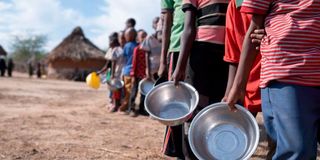Hunger hotspots: 2 million Kenyans in need of food aid due to last year’s poor rainfall

The number of children (six–59 months) requiring treatment for acute malnutrition rose from 760,488 to 800,202, while cases among pregnant and breastfeeding women increased from 112,401 to 120,732, signaling a worsening nutrition situation, especially in ASAL and urban areas, and heightened vulnerability among the two groups,” says the report.
What you need to know:
- 2.15 million people in Arid and Semi-Arid Lands counties urgently need humanitarian assistance, up from the one million recorded in July 2024.
- The most affected counties include Turkana, Mandera, Garissa, Wajir and Marsabit.
Last year’s short rains led to an increase in the number of people needing humanitarian assistance and more cases of children and pregnant women requiring treatment for acute malnutrition. This is according to the National Drought Management Authority (NDMA).
The report follows an assessment conducted across 23 Arid and Semi-Arid counties from January 20 to February 18, 2025 by the Kenya Food Security Steering Group, a multi-agency body consisting of government departments, UN agencies and NGOs.
The report, titled ‘2024 Short Rains Food and Nutrition Security Assessment Report,’ shows that 2.15 million people in Arid and Semi-Arid Lands (ASAL) counties urgently need humanitarian assistance, up from the one million recorded in July 2024. The most affected counties include Turkana, Mandera, Garissa, Wajir and Marsabit.”
“The number of children (six–59 months) requiring treatment for acute malnutrition rose from 760,488 to 800,202, while cases among pregnant and breastfeeding women increased from 112,401 to 120,732, signaling a worsening nutrition situation, especially in ASAL and urban areas, and heightened vulnerability among the two groups,” says the report.
The report listed the main drivers of food insecurity as below-average 2024 short rains, flash floods and displacement, high commodity prices, below-average crop production, human and livestock diseases, crop pests and diseases, and conflict and insecurity.
According to the report, 17 regions will be in a stressed acute food insecurity phase this month. They include West Pokot, Samburu, Isiolo, Meru, Laikipia, Baringo, Nyeri, Tharaka, Mbeere, Koibatek, Kitui, Tana River, Kajiado, Makueni, Kilifi, Kwale and Lamu.
A stressed acute food insecurity phase, according to World Food Programme, refers to a phase where households have minimally adequate food consumption but struggle to afford some essential non-food items without engaging in stress-coping strategies.
“They have unsustainable incomes, face difficulties meeting their basic needs and have to make some changes to support their non-food needs. In this phase, between five and 10 per cent of the population is acutely malnourished and a person takes in 2,100 calories per day, meaning they barely have an adequate diet to meet their food needs,” says WFP.
Turkana, Marsabit, Mandera, Wajir and Garissa counties will be on crisis acute food insecurity phase. In this phase, families either face food consumption gaps alongside acute malnutrition, or are only just able to meet their food needs; resorting to crisis coping strategies like selling off essential livelihood assets.
“There are limited food choices, and people must go to extreme lengths to get the calories they need. A total of between 10 and 15 per cent per cent of the population is acutely malnourished, and there is a serious interruption to people’s incomes.”
"The food security situation is projected to deteriorate further due to below-normal rainfall expected during this year’s March–May season, with an estimated 2.8 million people likely to experience acute food insecurity between April and June 2025,” says the report.
The alert comes barely a week after the Intergovernmental Authority on Development revealed that Somalia, eastern/northern Kenya, southern/northeastern Ethiopia, Djibouti, coastal Eritrea, western South Sudan, and southern/western Uganda will be experiencing drier-than-normal conditions due to reduced rainfall by between 40 and 60 per cent as from March to May 2025.
The alert also notes that the Northern Rift Valley counties of Kenya may “experience slightly better rainfall performance than the rest of the locations within the same sub-ecosystems."
As a result, these areas will become areas of confluence for competition over the resources.
Even though the alert reported a marked reduction in conflict incident counts in the just concluded October to December 2024 season, it forecast the likeliness of conflict for the March to May season.
The conflicts, said the alert, will likely be driven by depressed rainfall across most parts of the region, higher-than-normal temperatures, which will lead to rapid dissipation of resources and onset of dry conditions, and a likelihood of delayed onset of rains, which will “mean extended stays of migrating communities and of the dire conditions.”
“The areas with depressed rainfall will mostly experience secondary human safety insecurities due to the outmigration of herds and energetic manpower, leaving only the vulnerable populations behind, including women, children, and those with disabilities,” reads the alert in part.
“Other associated human safety insecurities will likely include starvation, increased child labour and tracking, increased domestic violence and sex workers leading to the spread of STDs, and further destruction of the environment due to unsustainable adaptive coping trades such as charcoal burning, bush burning for hunting of small mammals, poaching, brewing, and increased consumption of local alcohol, among others,” reads the alert.
It adds that the compounding effects of these factors will consequently initiate unfavourable, negative, and high conflict-risk adaptive behaviours, including out-migrations from the drier to areas with better environmental conditions or areas of relief.


